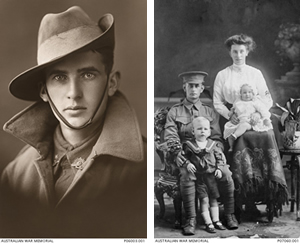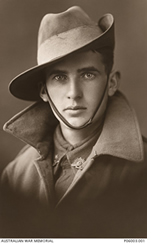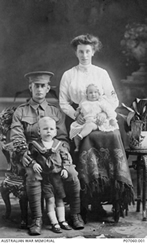History ES1
Overview

Left: Australian soldier, First World War. Right: Sergeant Sullivan and family, c. 1915.
©Public domain (AWM P06003.001, P07060.001)
Students investigate the significance of the Australian Army’s slouch hat. They compare family photographs from the First World War to those from today and consider the significance of family members in uniform. Students identify their roles and responsibilities in Anzac Day commemorations within their school community and discuss the significance of the Centenary of Anzac.
Teaching and learning activities

Australian soldier, WW1
©Public domain (AWM P06003.001)
1. Challenge — What stories do other people tell about the past?
-
Use images of a specific First World War icon such as a slouch hat with the rising sun badge.
-
Who wore these hats? Why did they wear them? When would these hats have been worn? Are they still worn now?
-
Look at the badge on the side of the hat holding the brim up (the slouch). What does this badge mean to those who wore the hat?
-
Do you think that a slouch hat and the rising sun badge would be a considered something special by the owner and their family? Give some reasons.
Suggested sources:
The slouch hat: Trademark of the Australian Army
The Australian Imperial Force (AIF) headwear 1914–1918

Sergeant Sullivan and family c. 1915
©Public domain (AWM P07060.001)
2. Change — How can stories of the past be told and shared?
-
View images of family photos from the First World War.
-
Use the captions to provide some context of the significance of these photos. Highlight the wearing of a uniform by a family member and the significance of this.
-
Locate the image in time and context, using historical language to describe the images.
-
Source family photos of today.
-
Students discuss similarities and differences between the First World War images and those of today.
-
Students categorise similarities and differences by drawing and describing the changes and continuities in family life over time.
Suggested sources:
AWM Image P11287.015.002 — Webster family
AWM Image P11212.001 — Private Filmer with his family
AWM Image P10904.004 — Bingley family
Learning concepts
These additional questions can be used for discussion or further investigations.
Challenge
How did the slouch hat provide protection from the weather?
Change
Compare First World War family images with those of today. What is the significance of a family member in uniform?
Community
How does the school community commemorate Anzac Day and Remembrance Day?
What are your roles and responsibilities during these commemorations?
Why are these days important at school and for the wider community?
Commemoration
What is the significance of the Centenary of Anzac? Why do we need to remember?
Syllabus links
HTe-1 communicates stories of their own family heritage and the heritage of others
HTe-2 demonstrates developing skills of historical inquiry and communication
Activity 1
How the stories of families and the past can be communicated, for example, through photographs, artefacts, books, oral histories, digital media and museums (ACHHK004)
-
discuss the significance of the chosen treasured object or photograph (it may be important or significant to themselves but not to others)
-
pose questions about another's object or photograph
-
discuss then and now; past and present
Activity 2
The different structures of families and family groups today, and what they have in common (ACHHK002)
-
compare and contrast various family groups through photographs and stories and identify differences between past and present